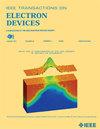w波段行波管低损耗传输结构研究
IF 2.9
2区 工程技术
Q2 ENGINEERING, ELECTRICAL & ELECTRONIC
引用次数: 0
摘要
提出了一种w波段行波管的低损耗传输结构。它将矩形波导基模TE10转换为准高斯能量分布的波纹波导HE11模式,从而降低了波导壁面上的欧姆损耗。从理论上分析了维持和产生HE11模式的部分。仿真结果表明,在80 ~ 100 GHz频率范围内,变换器的${S} _{{11}}$小于−20 dB,模式转换纯度达到99.66%。与传输损耗为4.5 dB/m的传统矩形波导相比,新型结构的插入损耗成功降低了3.1 dB/m,低至1.4 dB/m。此外,制作了相同长度w波段的低损耗传输结构和矩形波导,并进行了冷测试,结果表明插入损耗每米降低了2.5 dB,验证了仿真预测。通过烧点实验验证了HE11模式的能量分布。实验结果证实了所提出的低损耗传输结构在w波段行波管输入输出结构中低损耗传输的可行性。本文章由计算机程序翻译,如有差异,请以英文原文为准。
Investigation of a Low-Loss Transmission Structure for W-Band TWT
A low-loss transmission structure for W-band traveling wave tube (TWT) is proposed in this article. It converts the rectangular waveguide fundamental TE10 mode into the corrugate waveguide HE11 mode with a quasi-Gaussian energy distribution, thereby reducing ohmic loss on the waveguide walls. The sections maintaining and generating the HE11 mode are theoretically analyzed. The simulation results show that the ${S} _{{11}}$ of the converter is less than −20 dB in the frequency range of 80–100 GHz, and the mode conversion purity reaches 99.66%. Compared with a conventional rectangular waveguide with a 4.5 dB/m transmission loss, the insertion loss of novel structure has successfully been reduced by 3.1 dB/m to as low as 1.4 dB/m Furthermore, the same length W-band low-loss transmission structure and rectangular waveguide have been fabricated and cold-tested, the results reveal a reduction in insertion loss of 2.5 dB per meter, verifying the simulation predictions. A burned spot experiment was conducted to verify the energy distribution of the HE11 mode. The experimental results confirm the feasibility of the proposed low-loss transmission structure for low-loss transmission in W-band TWT input-output structures.
求助全文
通过发布文献求助,成功后即可免费获取论文全文。
去求助
来源期刊

IEEE Transactions on Electron Devices
工程技术-工程:电子与电气
CiteScore
5.80
自引率
16.10%
发文量
937
审稿时长
3.8 months
期刊介绍:
IEEE Transactions on Electron Devices publishes original and significant contributions relating to the theory, modeling, design, performance and reliability of electron and ion integrated circuit devices and interconnects, involving insulators, metals, organic materials, micro-plasmas, semiconductors, quantum-effect structures, vacuum devices, and emerging materials with applications in bioelectronics, biomedical electronics, computation, communications, displays, microelectromechanics, imaging, micro-actuators, nanoelectronics, optoelectronics, photovoltaics, power ICs and micro-sensors. Tutorial and review papers on these subjects are also published and occasional special issues appear to present a collection of papers which treat particular areas in more depth and breadth.
 求助内容:
求助内容: 应助结果提醒方式:
应助结果提醒方式:


